Inventions of the 1860s
Posted By Brian Tomlin on February 27, 2012
The following is a partial list of inventions that were developed during the 1860s. Photographs of the early models are provided whenever possible, as well as links to more information on the history of the items.
1860
- linoleum.
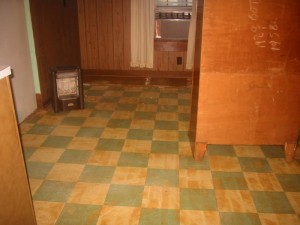 Made from renewable resources like linseed oil and pine resins, linoleum was first patented in 1860 by Frederick Walton. The very early processes were quite durable, and in wealthy homes the patterns were very intricate, sometimes copying patterns of oriental rugs. More common were plainer squares of linoleum tiles very common in kitchens and entry hallways well into the twentieth century. Shown is a photograph form a 1903 Victorian house showing early linoleum discovered during a renovation.
Made from renewable resources like linseed oil and pine resins, linoleum was first patented in 1860 by Frederick Walton. The very early processes were quite durable, and in wealthy homes the patterns were very intricate, sometimes copying patterns of oriental rugs. More common were plainer squares of linoleum tiles very common in kitchens and entry hallways well into the twentieth century. Shown is a photograph form a 1903 Victorian house showing early linoleum discovered during a renovation.
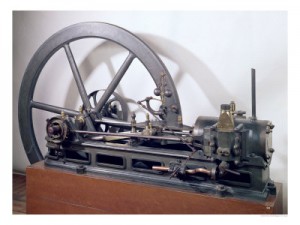 internal combustion engine. 1860: Belgian Jean Joseph Etienne Lenoir (1822–1900) produced a gas-fired internal combustion engine similar in appearance to a horizontal double-acting steam engine, with cylinders, pistons, connecting rods, and flywheel in which the gas essentially took the place of the steam. This was the first internal combustion engine to be produced in numbers.
internal combustion engine. 1860: Belgian Jean Joseph Etienne Lenoir (1822–1900) produced a gas-fired internal combustion engine similar in appearance to a horizontal double-acting steam engine, with cylinders, pistons, connecting rods, and flywheel in which the gas essentially took the place of the steam. This was the first internal combustion engine to be produced in numbers.
1861
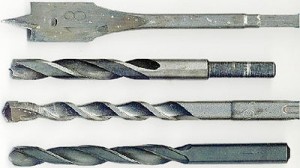 twist drill. Stephen Morse developed the idea of creating a twisted drill consisting of two parallel spiral grooves with a straight cutting edge. Prior to this, drills were made from a flat piece that was pointed and sharp.
twist drill. Stephen Morse developed the idea of creating a twisted drill consisting of two parallel spiral grooves with a straight cutting edge. Prior to this, drills were made from a flat piece that was pointed and sharp.
- postcard. The private postal card was developed by John P. Charlton of Philadelphia in 1861 for which he obtained the copyright which was later transferred to H.L. Lipman. The cards were adorned with a small border and labeled “Lipman’s Postal Card, Patent Applied For”. They were on the market until 1873 when the first Government Postcards appeared.
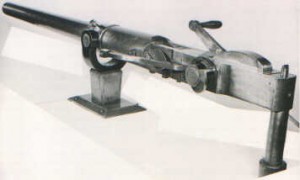 hand-cranked machine gun. The first machine-gun type weapon ever used in combat was built for the Confederate War Dept in Sept 1861. The Williams breech-loading rapid-fire gun was first used at the Battle of Seven Pines and worked so well that the War Dept ordered 42 more of them. The gun was actually a crank-operated, very light artillery piece that fired a one-pound (1.57 calibre) projectile with a range of 2,000 yards. It was operated by a crew of three and could fire at a rate of 65 rounds per minute. One operator aimed and fired the weapon by turning the crank, the second placed a paper cartridge into the breech, and the third placed the percussion cap. The major problem with this gun was overheating, which made the breech jam due to heat expansion. More info: http://theuscivilwar.tripod.com/weaponry.html
hand-cranked machine gun. The first machine-gun type weapon ever used in combat was built for the Confederate War Dept in Sept 1861. The Williams breech-loading rapid-fire gun was first used at the Battle of Seven Pines and worked so well that the War Dept ordered 42 more of them. The gun was actually a crank-operated, very light artillery piece that fired a one-pound (1.57 calibre) projectile with a range of 2,000 yards. It was operated by a crew of three and could fire at a rate of 65 rounds per minute. One operator aimed and fired the weapon by turning the crank, the second placed a paper cartridge into the breech, and the third placed the percussion cap. The major problem with this gun was overheating, which made the breech jam due to heat expansion. More info: http://theuscivilwar.tripod.com/weaponry.html
1863
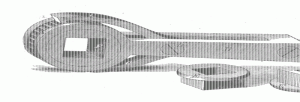 ratchet wrench. Invented by J. J. Richardson and patented on June 18, 1863, from the article about it inScientific American magazine. Instead of a male connector on the wrench, as modern socket wrenches have, in this tool the outside of the sockets (E) fit into the square hole (F) in the wrench. The ratchet (C) only turns in one direction; to turn nuts in the other direction the wrench is turned over and the socket is attached to the other side. 1864 article available here: http://digital.library.cornell.edu/cgi/t/text/pageviewer-idx?c=scia;cc=scia;rgn=full%20text;idno=scia1010-16;didno=scia1010-16;view=image;seq=00252;node=scia1010-16%3A1
ratchet wrench. Invented by J. J. Richardson and patented on June 18, 1863, from the article about it inScientific American magazine. Instead of a male connector on the wrench, as modern socket wrenches have, in this tool the outside of the sockets (E) fit into the square hole (F) in the wrench. The ratchet (C) only turns in one direction; to turn nuts in the other direction the wrench is turned over and the socket is attached to the other side. 1864 article available here: http://digital.library.cornell.edu/cgi/t/text/pageviewer-idx?c=scia;cc=scia;rgn=full%20text;idno=scia1010-16;didno=scia1010-16;view=image;seq=00252;node=scia1010-16%3A1
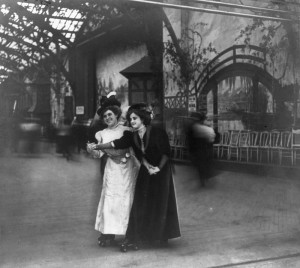 quad roller skates. The four-wheeled turning roller skate, or quad skate, with four wheels set in two side-by-side pairs, was first designed, in New York City by James Leonard Plimpton in an attempt to improve upon previous designs, The skate contained a pivoting action using a rubber cushion that allowed the skater to skate a curve just by leaning to one side. It was a huge success, so much that the first public skating rink was opened in 1866 in Newport, Rhode Island with the support of Plimpton. The design of the quad skate allowed easier turns and maneuverability, and the quad skate came to dominate the industry for more than a century.
quad roller skates. The four-wheeled turning roller skate, or quad skate, with four wheels set in two side-by-side pairs, was first designed, in New York City by James Leonard Plimpton in an attempt to improve upon previous designs, The skate contained a pivoting action using a rubber cushion that allowed the skater to skate a curve just by leaning to one side. It was a huge success, so much that the first public skating rink was opened in 1866 in Newport, Rhode Island with the support of Plimpton. The design of the quad skate allowed easier turns and maneuverability, and the quad skate came to dominate the industry for more than a century.
- barbed wire. Prior to 1863, several individuals created forms of fencing that could be considered as barbed wire. None of these creations ever reached the mass market. In 1863 by Michael Kelly developed a type of fence with points affixed to twisted strands of wire.
- paper dress patterns. Ebenezer Butterick invented the commercially produced graded home sewing pattern in 1863 (based on grading systems used by Victorian tailors), originally selling hand-drawn patterns for men’s and boys’ clothing. In 1866, Butterick added patterns for women’s clothing, which remains the heart of the home sewing pattern market today.
- railroad sleeping cars. Although railroads had used early versions of sleeping cars since the 1830s, they were not massed produced or made profitable or popular until George Pullman began by building a luxurious sleeping car (named Pioneer) in 1865. The Pullman Company owned and operated most sleeping cars in the United States until the mid-20th century.
1866
- urinal for restrooms. The first urinals appeared and were patented in the United States. This happened in the period shortly after the Civil War that tore the country apart. These first urinals were very similar to the ones used today. They were presented in 1866 and a man called Andrew Rankin is the person responsible for this creation.
1867
 motorcycle. The first “motorcycle” to have two wheels with steam propulsion was built by Sylvester Howard Roper of Roxbury, Massachusetts in 1867. There is an existing example of a Roper machine, dated 1869. It’s powered by a charcoal-fired two-cylinder engine, whose connecting rods directly drive a crank on the rear wheel. This machine predates the invention of the safety bicycle by many years, so its chassis is also based on the “bone-crusher” bike.
motorcycle. The first “motorcycle” to have two wheels with steam propulsion was built by Sylvester Howard Roper of Roxbury, Massachusetts in 1867. There is an existing example of a Roper machine, dated 1869. It’s powered by a charcoal-fired two-cylinder engine, whose connecting rods directly drive a crank on the rear wheel. This machine predates the invention of the safety bicycle by many years, so its chassis is also based on the “bone-crusher” bike.
- typewriter. In 1867, Christopher Latham Sholes was working on a machine to automatically number the pages in books, when one of his colleagues suggested the idea might be extended to a device to print the entire alphabet. An article from “Scientific American” was passed around, and the gentlemen nodded in agreement that “typewriting” (the phrase coined in SA) was the wave of the future. Sholes thought of a simple device with a piece of printer’s type mounted on a little rod, mounted to strike upward to a flat plate which would hold a piece of carbon paper sandwiched with a piece of stationery. The percussive strike of the type should produce an impression on the paper. Sholes’ demonstration model looked like this:
 Sholes’ 1868 demonstration model
Sholes’ 1868 demonstration modelWith the key of an old telegraph instrument mounted on its base, Sholes would tap down on his model, and the little type jumped up to hit the carbon & paper against the glass plate. There was nothing for spacing, line advance or any “normal” typewriter feature. Those were all to come. It seems silly, but in 1868, the mere idea that type striking against paper to produce an image was totally new. It needed proving, and the little telegraph key model did the trick. Original source: http://home.earthlink.net/~dcrehr/firsttw.html
- dynamite. Throughout the 1860s Alfred Nobel experiemented with nitroglycerin and created the world’s first dynamite. More information: http://inventors.about.com/od/dstartinventions/a/Alfred_Nobel.htm
1869
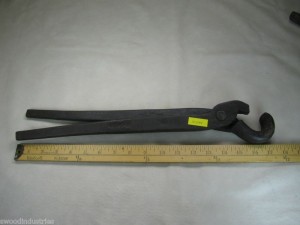 pipe wrench. The first pipe or stillson wrench was created by Daniel C. Stillson while working as a mechanic at the Walworth Company.
pipe wrench. The first pipe or stillson wrench was created by Daniel C. Stillson while working as a mechanic at the Walworth Company.
 ;
;


[…] feel better about the fact that I sew practically everything by machine. In the end I ran across a random snippet about the fact that the first paper patterns were invented in the […]
This was a good site to use for a quick search on finding an invention. But if possible (I know this will take a while) try and expand on what you have written.
Thanks,
James O’Hagan
i need help on an english persuasive essay help me choose a topic plz
thx for the help
You need to capitalize the pa in the title